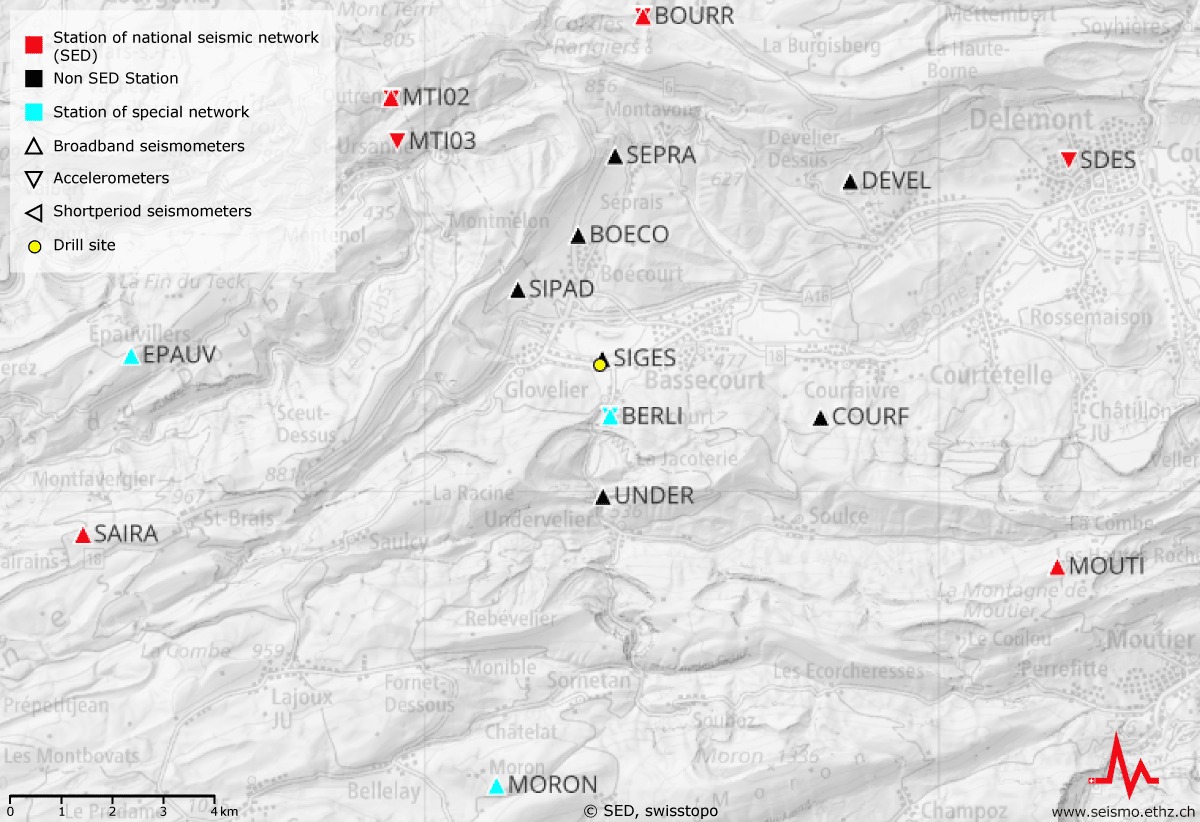2025-06-16
SED monitoring test stimulations for Haute-Sorne geothermal project (canton of Jura)
On Monday, 16 June, the canton of Jura granted approval for test stimulations as part of the geothermal project in Haute-Sorne (JU). These tests will involve forcing pressurised water into the geological underground through the exploratory borehole which was drilled in summer 2024. The water will emerge around four kilometres below the surface before filtering into the adjacent rock. The test stimulations are intended to trigger many minor earthquakes far below the sensitivity threshold. The resulting seismic waves will provide a detailed image of the local subsoil and show how permeable it is. The process will be closely monitored using a variety of measuring techniques.
Water being forced into the crystalline basement changes the local stress regime. This usually triggers minor, unfelt seismic events. These play a key role in opening up existing fractures enough for the water to circulate and warm up in a downstream reservoir. The test stimulation will help the operator, Geo-Energie Jura, determine the permeability of the rock and the impact of the volume of injected water on this property, yielding conclusions that will make a vital contribution to the potential roll-out of the deep geothermal project in Haute-Sorne. If the test stimulations give promising results, a second, slightly deeper borehole would be drilled and the existing hole would be expanded laterally. However, this will depend on the Canton of Jura approving the project.
The Swiss Seismological Service (SED) at ETH Zurich performs independent baseline seismic monitoring for the planned deep geothermal project in Haute-Sorne as part of the GEOBEST2020+ project funded by the Swiss Federal Office of Energy (SFOE) and under an agreement with the Canton of Jura (see Geothermal energy Haute-Sorne). To this end, the SED has expanded the seismic network in the canton of Jura. Based on automated data analysis, the SED immediately publishes all the events recorded in the region in the lists and maps of earthquakes on the project website. At the same time, the respective cantonal authorities and the operator receive an automatic notification. Seismologists from the SED then check whether it is actually an earthquake. They check the exact location and magnitude and correct this data if needed. During the test stimulation, the SED also examines each recorded earthquake within 48 hours to determine whether it was caused ('induced') by the stimulation or is of natural origin (see 'How does the SED categorise natural and (human-)induced earthquakes?' ). A categorisation is given in the 'Event Type' column of the list of earthquakes.
The minor, unfelt seismic events targeted during test stimulation provide important information that makes it possible to update risk assessments and assess the economic viability of the potential reservoir. The test stimulation is carried out based on a previously defined safety protocol, which it is envisaged will also be used for the subsequent, more extensive stimulation of the actual reservoir. If predefined threshold values are reached, the test stimulation will be adjusted or stopped. The aim here is to prevent undesired major or even felt quakes from occurring. For this purpose, Geo-Energie Jura uses not only data from the SED stations but also recordings from its own sensors. These include seismometers installed directly in the borehole at the point where the water is injected deep underground. It can thus be assumed that with these sensors Geo-Energie Jura will record very minor events (with negative magnitudes), which are substantially below the SED network's detection threshold of approximately 0.1 (MLhc).
How does the SED categorise natural and (human-)induced earthquakes?
Earthquakes can be of natural, tectonic origin or be triggered by human activity. The latter are called induced quakes. They can occur in connection with large-scale technical interventions in the geological underground.
Seismograms of induced earthquakes are no different from those of natural earthquakes. A number of indicators provide information about the origin of earthquakes. These include the spatial distribution of the quakes, their depth and how closely they occur in time to interventions in the geological underground. For this reason, no categorisation can be carried out as a result of automatic assessment. In manual assessment, an earthquake is categorised by default as an earthquake of natural origin. Only after additional testing can the category change and an earthquake be referred to as 'induced'.
The categorisation of earthquakes as natural or induced is based on the best information available at the time of assessment. The categorisation is shown in the 'Earthquake Type' column and is always subject to some uncertainty. The SED follows international, publicly available guidelines for categorisation (see E-PIE scheme). However, the categorisation is based on the judgement of experts. If further data becomes available at a later date, a reassessment may take place and an earthquake that was initially categorised as 'induced' may be classified as 'natural' again.
The SED does not distinguish between 'induced' and 'triggered' earthquakes, although these terms are sometimes used to indicate whether human activities are considered to be primarily responsible or only marginally responsible for an earthquake. This is because of the substantial uncertainty surrounding this and the lack of a scientific consensus as to whether making such a distinction is even meaningful or possible.
